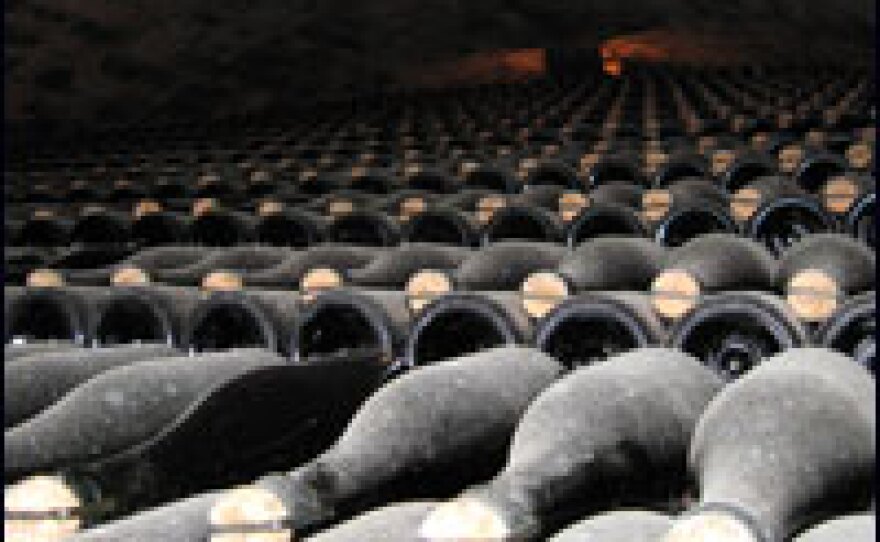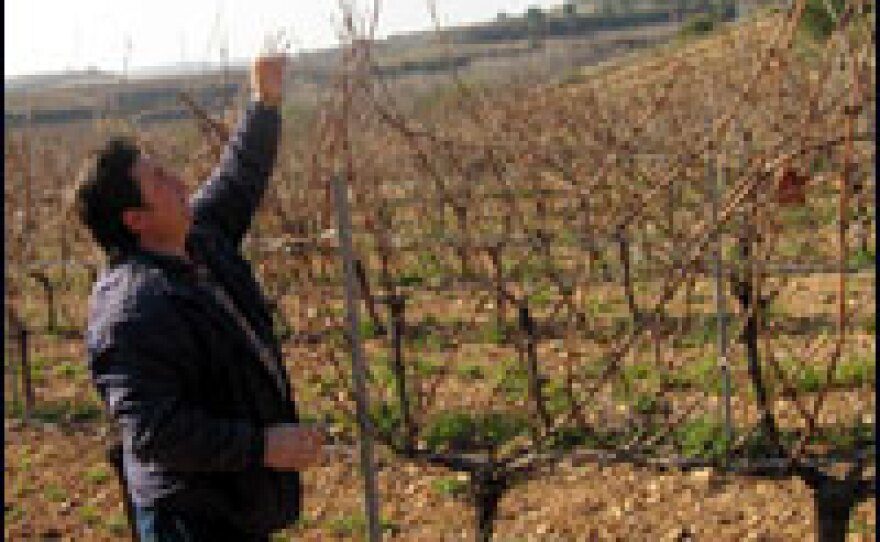


Later this week, winemakers and scientists from around the world will meet in Barcelona to discuss the threat to their industry from climate change.
Nearby, in the vineyards of the Penedes Valley, makers of the sparkling wine known as "cava" have already started taking steps to adapt.
In the village of Sant Sadurni d'Anoia, there's a bodega making cava on almost every street. In Jaume Gramona's winery, founded in 1881, he walks down the narrow staircase into the cavernlike cellars that give cava its name.
"Each cellar is named after a family member," he says. "On the upper level, you have my father and my mother. Here's my aunt, and over there's my uncle."
The dust-covered bottles of cava are stacked in endless rows reaching up to the vaulted ceilings. There are hundreds of thousands of bottles in the subterranean labyrinth. A few hundred are in the last stages of fermentation. Each of them is rotated by hand an eighth of a turn every day.
Gramona uncorks a bottle to disgorge the sediment left by eight years of fermentation. After he recorks it, it's ready for sale.
Cava More Vulnerable
The Gramona cava winery is one of the few that still uses the hand-corking method for its best vintages — the gran reservas. It's a small operation, dwarfed by other, bigger producers in Sant Sadurni d'Anoia.
But the future of all cava wineries in the area will depend on how well they can adapt to climate change. Cava is more vulnerable than still wine to changes in weather conditions as the grapes grow.
Just outside Sant Sadurni, in the heart of the Penedes Valley, grower Joan Pages tends the vines in Gramona's vineyards. He lets the vines grow higher now, to create more shade, and he trims them differently.
"We're taking away the leaves only on the side of the morning sun and letting them grow on the other side," he says, "because the afternoon sun is stronger and its ultraviolet rays can burn the grape's skin."
Winegrowers in the Penedes are harvesting earlier, and some even collect grapes at night.
Gramona has built a rainwater reservoir to cope with lengthening dry spells.
'It Used to Rain and Rain and Rain'
A recent study of winegrowing areas around the world found that average temperatures have increased by 2 degrees in the past 50 years. According to the Wine Academy of Spain, grapes are ripening faster, sugar and alcohol content are rising, and the aroma is losing its complexity.
Pages, 41, says things have certainly changed since he was a child on his father's vineyard.
"I remember how for weeks it used to rain and rain and rain," he says.
Gramona and 26 other winemakers are trying new techniques to cope with global warming. They are adding nutrients to the soil, using satellites to monitor vineyard conditions and trying new grape varieties — even moving vineyards higher up the steep slopes of the Penedes Valley.
The winemakers are planning a four-year study that will cost $370 million. Gramona will contribute more than $1 million. It's a big investment for a small cava maker, but he's confident it will bear fruit.
"I think we will go on making cava here for many years," he says.
Copyright 2022 NPR. To see more, visit https://www.npr.org. 9(MDAzMjM2NDYzMDEyMzc1Njk5NjAxNzY3OQ001))







